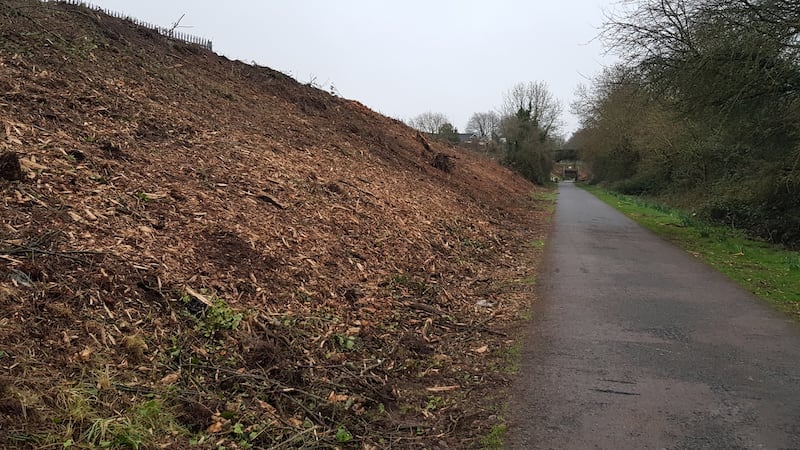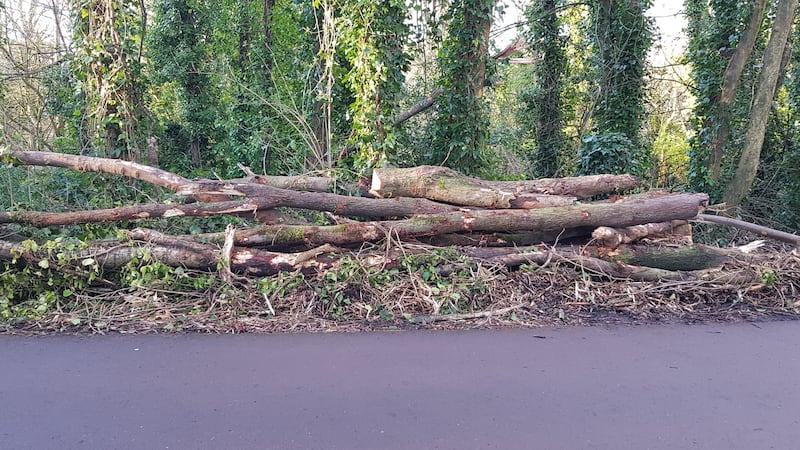Concerns have been expressed by politicians and environmentalists about clearance work which has seen dozens of trees felled and vegetation removed as part of a planned upgrade of one of Cork’s premier greenways.
Dozens of mature trees have been felled and large swathes of vegetation removed from a section of the Blackrock to Passage West Greenway as part of a proposal to widen the greenway and upgrade it to make it more accessible and safe.
But the clearance work, which began last month, has shocked many in the area. Cork City Council Environment Committee chairman counsellor Dan Boyle of the Green Party said he plans to seek a report from the council about the scale of the clearance and the manner in which it has been done.
“I have serious concerns about the manner in which this work has been done – there are serious questions to be asked about the scale of the clearance and the methods that have been used because it seems that it was done without anything like the appropriate level of sensitivity.
“We knew that the work would involve the removal of some trees but I don’t think the public or public representatives expected anything like the number of trees that have been felled would be removed or that as much vegetation would be cleared along the embankments and cuttings.”
Mr Boyle said Cork City Council is about to appoint a Tree Officer and if one had been in place when the clearance work commenced last month, he had no doubt but that they would have had a significant input to ensure that the clearance was done with far greater sensitivity.
“It’s the scale of the clearance that is shocking people – quite a lot of it had to be removed because trees were dead and I know there is a commitment to replant trees to a higher level but there seems to be no incentive to clear sensitively – it seems to be all about clearing as widely as possible.

“There seems to be a mania, a fetish to beautify through engineering but nature is okay as it is,” said Mr Boyle who said he will be seeking a full report on the work from the council, including details on what damage or interference the clearance work has had on wildlife living in the area.
Eoin Lettice of the School of Biological, Earth and Environmental Science at UCC, also expressed dismay at the scale of the clearance work and the impact it will have on the local ecosystem which has developed along the greenway since the Blackrock to Passage West railway closed in 1932.
“I was taken aback by the extent of the clearance – I know the council says it is going to replace X number of trees and replacing trees and putting saplings there is better than nothing but I think a much better approach would have been to carefully manage what was removed,” he said.
“And the problem is not just the trees – I’m very keen on trees but what they seem to have done here is take out not just the trees but they have also taken out the vegetation underneath and in places, it’s just bare soil and that’s going to impact on wildlife such as foxes and rabbits and birds.
“I’m all for developing the greenway to get more people out walking and cycling it but the value of the greenway was that you walked through there and even though you were under Blackrock, it was all very removed from the built up urban environment and very wild and very natural.
“What you had there was an ecosystem that had taken almost 100 years to develop along the route of the old railway line, you can’t replace that overnight – this idea that you can come along and plant 100 or 200 or even 500 trees and replace what was there is just not correct.
“It’s going to take another 100 years for that area to return to what it was – you had 100 years of growing balanced ecosystem with all the interactions going on – this has been wiped clear in just a few days and planting trees in a very managed sterile way isn’t going to create a similar wild space.”
The Irish Wildlife Trust also expressed concern about the clearance work on the Blackrock to Passage Greenway. "Greenways are supposed to enhance our ability to enjoy nature but increasingly we see they destroy nature in order to provide that access," it tweeted.
According to Cork City Council, the recent work on the Marina and Mahon section of the greenway is aimed at "upgrading the amenity corridor for pedestrians and cyclists while improving the natural environment along the route by encouraging its development as a living, green corridor".

Cork City Council said in a statement that the project involves widening the existing paved walkway from 3 metres to 5 metres as well as upgrading the existing ramps and providing a new ramp on to the greenway to facilitate access for people living in the area.
The project also involved the provision of public lighting and CCTV for security and to ensure pedestrians and cyclists feel comfortable using the space after dark while it will also include the provision of seating for people, said the council.
According to the Council, ecologists and tree specialists are overseeing the project which will see the planting of 65 semi-mature native Irish trees and over 2,000 saplings along the greenway to replace 46 trees including some dead and dangerous ones that had to be removed to improve access.
The felling of the trees was specifically timed to avoid the bird nesting season while the project will also see the installation of bat roosting boxes, bird nesting boxes and bee supporting habitats as well as interpretation boards along the route, said the council.
“An ecologist was on site supervising the works for the full duration of the clearance activities . . . extensive surveys were undertaken in advance of the works, and careful checks were completed prior to the commencement of works to minimise any negative effects on wildlife,” it added.
“Cork City Council at all times seeks to avoid unnecessary felling of trees. We were advised by our ecology and aborology teams that any loss in habitat will be more than mitigated by the extensive number of new replacement trees which will be planted along the greenway.”














